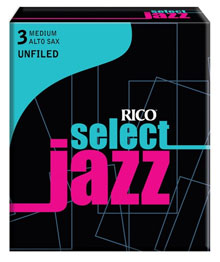Reviewed: A Collection of Rico Products You May Not Have Tried Yet
 Over the course of my playing career I have tried countless saxophone accessories and reeds from many manufacturers. The first box of reeds I ever played on was a Rico orange box. I later moved on to the Rico Royals and then continued to try more and more reeds from different manufacturers to see how these reeds played in comparison to the Rico reeds.
Over the course of my playing career I have tried countless saxophone accessories and reeds from many manufacturers. The first box of reeds I ever played on was a Rico orange box. I later moved on to the Rico Royals and then continued to try more and more reeds from different manufacturers to see how these reeds played in comparison to the Rico reeds.
Recently, I noticed that over the past couple of years, Rico has introduced new reeds and accessories into the marketplace. Since I had not had the chance to try some of Rico’s most recent products, I decided to reach out to Rico and was able to receive some of their newest products to demo.
Rico H Ligature
 I have been using an Eddie Daniels Rovner ligature for my alto saxophone and was sent a Rico H-ligature and cap to see how this ligature compared to my current setup. The Rico H-ligature is based on the popular Harrison ligature which was used by famous alto saxophonist David Sanborn. The Rico H-ligature has 4 points where it touches the reed. The aim of this design is to allow the reed to vibrate more than your average stock ligature.
I have been using an Eddie Daniels Rovner ligature for my alto saxophone and was sent a Rico H-ligature and cap to see how this ligature compared to my current setup. The Rico H-ligature is based on the popular Harrison ligature which was used by famous alto saxophonist David Sanborn. The Rico H-ligature has 4 points where it touches the reed. The aim of this design is to allow the reed to vibrate more than your average stock ligature.
I found that using this ligature resulted in a sound that was bit darker in comparison to my Eddie Daniel ligature. It was very easy to put on and adjust, and the cap that it comes with is by far one of the best designed protective caps on the market.
The Rico H-ligature is a great addition to the line of accessories Rico offers, and is by far one of the best and most cost-effective options for any saxophonist looking to upgrade from a stock ligature.
Click here for more information on the H-ligature.
Rico Reserve tenor reeds
 When I first saw the Rico Reserves for tenor saxophone, I thought they were meant for the classical saxophonist. But after speaking to Seamus Blake about his experience playing on the Rico Reserve reeds, I knew I had to try them.
When I first saw the Rico Reserves for tenor saxophone, I thought they were meant for the classical saxophonist. But after speaking to Seamus Blake about his experience playing on the Rico Reserve reeds, I knew I had to try them.
When I began playing the Reserve reeds for tenor, I noticed that they were a bit on the hard side. I decided to use some sandpaper (as I’ve had to do with the the Rico Jazz Select reeds) to shave them down bit and make them more free-blowing.
According to Rico, “The Reserve reeds are filed and feature a thicker spine and blank, allowing for ease of register changes. The Reserve reed is ideally suited for solo and chamber performance. Reserve reeds are made from lower-internode cane, which comes from the first four tubes of the cane stalk, yielding greater consistency from reed to reed.”
I can see after playing them why many classical saxophonists would enjoy playing on them due to the full yet delicate sound they produce, but I also believe that many jazz saxophonists should give them a try. I liked the Reserves because they seemed to last over long periods of constant playing, as well as the fact that they produced a very rich and full sound without sounding too thin or harsh.
My recommendation would be to review Rico’s reed comparison chart to find the right strength before trying these Rico reeds.
Rico Multi-Instrument Reed Case
 For many years, I used to store my reeds in a clear plastic bottle with either a little bit of water or vodka to keep the reeds from drying out. The method also decreased the chances of any of my reeds warping.
For many years, I used to store my reeds in a clear plastic bottle with either a little bit of water or vodka to keep the reeds from drying out. The method also decreased the chances of any of my reeds warping.
I have heard about the Rico reed case, but never really knew how it worked. The first thing I liked about the Rico case when it arrived was its size as well as the fact that it was incredibly simple to use. The reed storage case came with a 73% vitalizer pack, which simply is placed inside the case to keep your reeds at a certain humidity.
You can store up to 8 reeds in this case from clarinet to bari sax. After having two tenor, two alto, and one soprano reed in the case over the past 2 weeks, I have not seen any of my reeds warp or dry out. I found this case to be a great way to transport reeds (especially if you have a gig bag). I have not had the opportunity to test out the 3 different vitalizer packs but can say that the 73% pack works well with my reeds.
Rico Reed Vitalizer Packs
- 58- “stable storage”
- 73- “requires minimal wetting”
- 84- “ready to play”

Rico Jazz Select reeds (Unfiled)
 I have tried the Rico Jazz Select Filed reeds for tenor, but had never tried the unfiled cut until recently. I generally play on Rigotti’s, Alexander’s D.C. & Superial, and Roberto’s Woodwinds reeds, but will soon add the Rico Jazz Select 3 Unfiled reeds to my lineup.
I have tried the Rico Jazz Select Filed reeds for tenor, but had never tried the unfiled cut until recently. I generally play on Rigotti’s, Alexander’s D.C. & Superial, and Roberto’s Woodwinds reeds, but will soon add the Rico Jazz Select 3 Unfiled reeds to my lineup.
When I played through all five Rico Jazz Select reeds, I found out that I would probably enjoy playing on the 2 hard because the 3 soft were a bit too stiff. Using some sand paper (600 grit), I shaved the reeds down so they would be easier to play on. After shaving them down, they started to become much easier to play on and I could now gain a better understanding of how the Rico Jazz Select Unfiled played in comparison to the other brands I play on.
I could say that while I was playing through the Rico Jazz Select reeds, I was able to get a very clean upper register sound that was clear and full (especially in the palm keys). The bottom end down to the low Bb was very powerful, but I could also get a nice sub-tone that I could keep well in tune.
These reeds reminded me of the Rigotti Gold, Alexander, and Roberto’s Woodwinds reeds that I am used to playing. The Jazz Selects allowed me to gain an edgy sound in the vein of Chris Potter when playing in the altissimo, or a sweet straight-ahead sound like Eric Alexander (at least that is what I perceived).
I would recommend the Rico Jazz Select Unfiled reeds for anyone looking for a bit more edge in their sound. Out of the five reeds I tried, I found three that I have been cycling thru and enjoy playing on, one that is a bit stiff but will use for practicing, and one that I will keep working on until I can get it to play throughout the horn.
Click here to learn more about Rico Jazz Select Unfiled reeds.
Overall Thoughts
Since I started playing on Rico reeds in 6th grade, I could tell that Rico was constantly working on improving their products as well as listening to what players are looking for in their sound. I would highly recommend checking out Rico’s product line because they have always offered great products at affordable prices, which is why so many players continue to play and stand by Rico.






January 3, 2013 @ 11:26 am
Although it might be a decent ligature on its own, I found that the Rico H bore no resemblance to my classic handmade Harrison ligature for alto.
January 4, 2013 @ 8:59 am
Hey Miguel,
I know the original harrison ligature is different from the new rico h ligature. I know some players prefer the old harrison over the new rico h ligature. I really enjoyed the simplicity of the rico h ligature and the way it worked on my mouthpiece. I know the old harrison ligatures are great but are priced typically around $100+ for the old ones. I appreciate your comments and why do you like the old harrison over the new rico h ligature?
Thanks,
Zach
January 3, 2013 @ 4:13 pm
I actually use the Rico Reserves for my Alto set up and I was blown away by this reed.
January 4, 2013 @ 1:21 pm
Hey Tibbs,
What is your alto saxophone setup?
Zach
January 4, 2013 @ 1:32 pm
Hey Zach,
My setup is a Meyer 5 with a Bonade ligature on a Mark VII Alto.
Tibbs
January 3, 2013 @ 5:01 pm
Hi Zach, thanks for sharing your experiences about these products. I use the Rico reed cases, and really like them a lot. They keep my reeds more stable, and longer lasting. One question: If you play on a Rico Select Jazz 2H, what is (in you experience) the equivalent strength in the Rico Reserve?
January 4, 2013 @ 8:52 am
Hey Bill,
I was on Rico’s website and found a reed comparison chart (see link below).
[Sorry(!), but this web page has disappeared since the original publication of this comment]
a 2H rico jazz select falls within a 2.0 and 2.5 strength in a rico reserve cut. I would recommend the 2.5 reserve just because if they are a bit stiff you would have a chance to shave them down to the right strength. The 2.0 strenght could work well but it might be a bit soft.
Hope this helps
Zach Sollitto